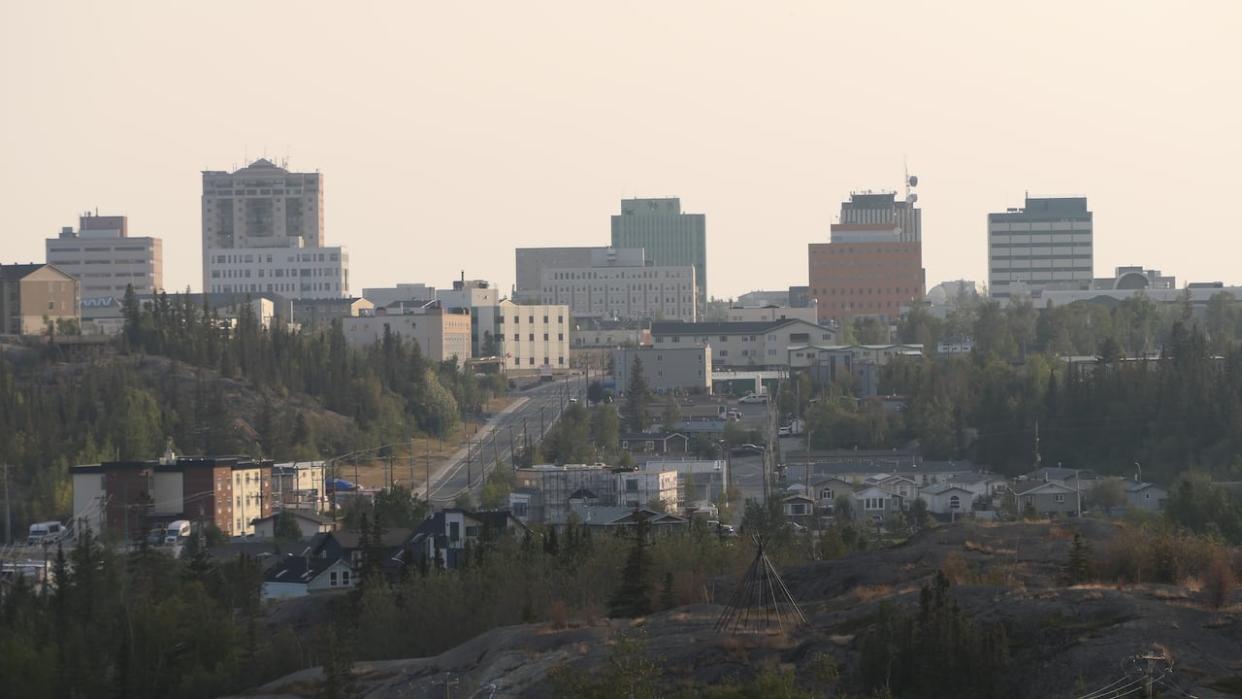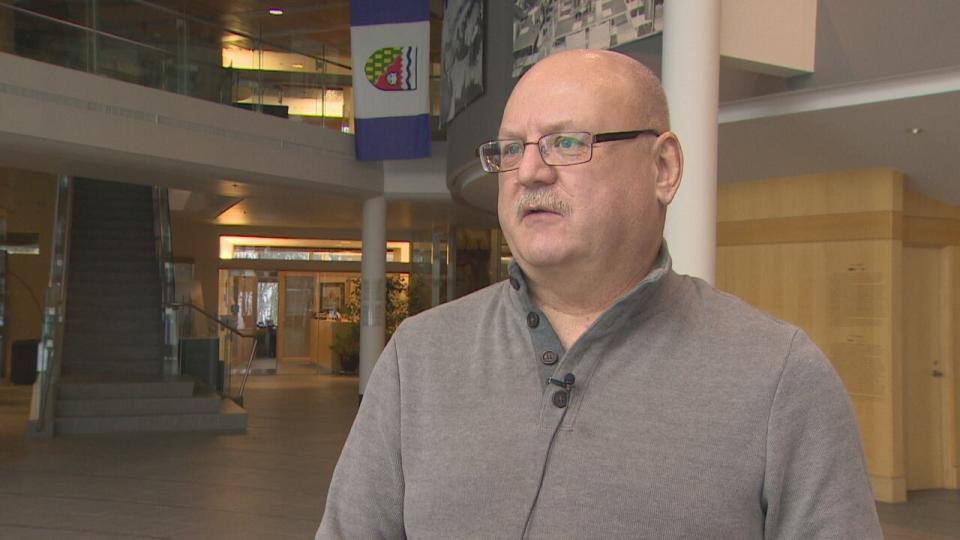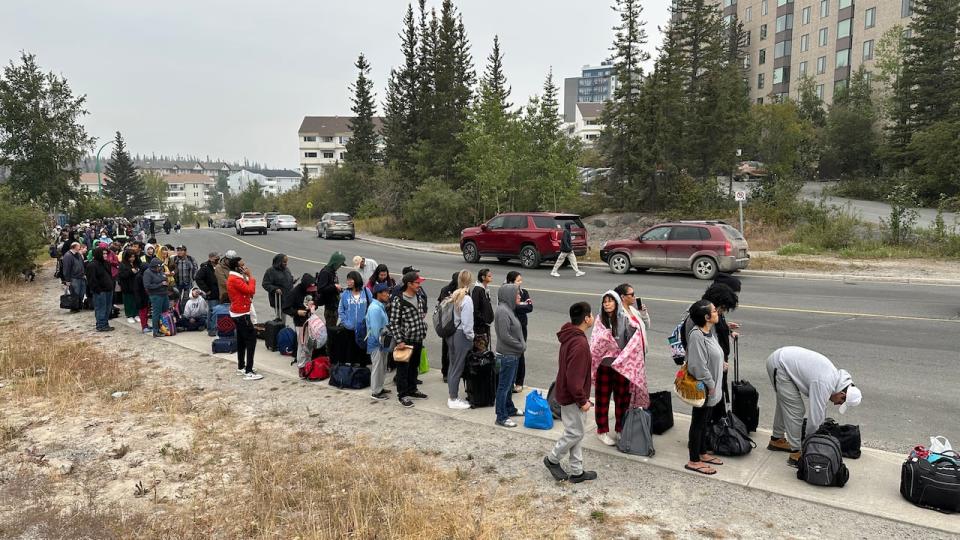N.W.T. minister says lack of staff for shelter-in-place plan triggered Yellowknife's full evacuation

The day before the N.W.T. government declared a city-wide evacuation order for Yellowknife due to wildfire, city officials realized they didn't have enough staff for their plan to shelter in place.
Shane Thompson, the N.W.T.'s minister of Municipal and Community Affairs as well as Environment and Climate Change, told CBC it wasn't until Aug. 15 that city officials asked the territory for help with its plan and for coming up with a scenario for a possible city-wide evacuation.
That request came after a press conference where city officials declared an evacuation alert for the Kam Lake business district, Grace Lake and Engle industrial areas, and Mayor Rebecca Alty said the Multiplex and fieldhouse would be turned into evacuation centres if the alert was upgraded to an order.
The details come as part of an emerging picture of the hectic days leading up to the evacuation and how a last-minute evacuation of the city happened.
Thompson said Wednesday morning in an interview with Trailbreaker host Hilary Bird that the reason the city was evacuated was because Health and Social Services (HSS) staff had started leaving and there weren't enough people to run a city evacuation centre, meaning the city's original plan wouldn't be viable.
Thompson said the territory started working to evacuate Yellowknife as soon as the city reached out with those concerns.
"So we made the decision, collectively, to evacuate the city — and ... to this day, I would still make the same decision," he said.
In a follow-up email with more details, Thompson wrote that the Northwest Territories Health and Social Services Authority was experiencing "capacity issues" in the days leading up to the evacuation.
He said that's because they were opening Stanton Legacy on an emergency basis for long-term care and supported living clients. Staff were trying to plan for how to evacuate those patients, as well as inpatients at the hospital, while also trying to get the Multiplex ready to host other evacuees.
"Given these capacity issues, NTHSSA was not able to further support the City with its shelter-in-place plan — a much different plan than hosting an evacuation centre — which prompted municipal officials to reach out to the GNWT to assist with its plan and a scenario for a city-wide evacuation," he wrote.
It was only after that that officials realized sheltering in place wouldn't be "suitable" because the wildfire was threatening "large-scale evacuation routes" and air quality was becoming a concern.
In response to Thompson's comments on the Trailbreaker, City of Yellowknife spokesperson Abby Schelew said only that in running a Yellowknife evacuation centre, the City provides the reception centre (such as the multiplex) and HSS "provides for the needs of the evacuees/disaster victims."
"On Aug. 15, the City reached out to the GNWT to request support including for evacuation support, and the GNWT responded," Schelew said in an email.
During Wednesday's interview, Thompson answered a range of questions about government decisions and timelines related to evacuations in the N.W.T., including ones in the South Slave.
This Q&A has been edited for clarity and length.
While everyone, or mostly everyone is able to go home, there is still a lot of trauma, especially from people who had to flee Hay River and Enterprise and drove that highway out of town with fire burning on either side of the road.
Minister, can you tell us, how did that happen that people were instructed to drive that highway under those conditions?
So basically the community was going to be on alert. I had a conversation with the mayor and she realized that they needed to evacuate because the tinderbox in between Kakisa, Enterprise and Hay River was coming. They tried to get everybody out as soon as they could.
Unfortunately, that fire exploded like we've never, ever seen before and caused some challenges as we evacuated. Fortunately, we didn't lose anybody. If we could have been able to get them out earlier, we would have, but unfortunately the situation happened the way it did.
But why weren't you able to get people out earlier at that time?
It was just the way the fire was reacting. It moved like 42 kilometers in four hours — the winds blew and it was just a wall of fire that caused the fire to move to the direction where it did.
I want to move to Yellowknife and ask you about the decision to evacuate the capital. The city's plan was initially to just shelter in place. Who ultimately made the decision that it should be a full-scale evacuation and why was that decision made?
After the press conference, [the city] was talking about sheltering in place. We got an e-mail from the city asking us — if we couldn't shelter in place because we wouldn't be able to set up the evacuation centres, then we would have to look at other alternatives.
As soon as the city reached out to us, we then started working on how to evacuate the city. The biggest thing was that Fire 11 and 15 (the Ingraham Trail fire and the Behchokǫ̀/Yellowknife one) were going to close the road down, the airport was going to be non-usable and we would have 22,000 people stuck in a situation where the fire would cause lots of problems. So we made the decision collectively to evacuate the city, and today, I would still make the same decision.
I've had reports saying, well, we shouldn't have done it — but I've also had people say, we learned from Fort McMurray where they didn't evacuate as soon as they could have. And we got lucky and we were able to make the right decision to get everybody out.
But we did essentially go from an evacuation alert for one part of the town to immediately an evacuation order for the entire city. Can you walk us through how that happened and was it you who ultimately made the call to evacuate the city?
So the city reached out to us after the press conference. They said, we wouldn't be able to have our evacuation centres stood up because our health and social services department was leaving. So they asked us what we were going to do, how we could work together to get the residents out of there.
So we set up an evacuation plan that within basically 60 hours we would like to get everything done, because we knew the fire was going to hit on that Saturday and it was going to close the roads ... [and] also cause the airport to be unable to transfer people out. So at that time, we made the decision that we need to evacuate.

Shane Thompson is the N.W.T. minister of Municipal and Community Affairs, as well as Environment and Climate Change. (Randall McKenzie/CBC)
You did a press conference in the evening, but many people, including public servants, had left the territory at that point. Do you regret the way that that was handled, that so many people, including people who work for the government had left before people had ultimately been told that there was an evacuation order?
I can't say how this information got out there. We weren't even looking at evacuating people until we made that decision. I was talking to some people that basically had friends in Fort McMurray and they said if you get a chance to leave, leave. So a lot of people that did leave before we even did the order started leaving because they knew from the experience of McMurray that they should leave.
As for how government services people got that information and started leaving, because I can tell you I had conversations with people probably an hour before we had made the decision, and I said you needed to follow the city plan. So until that time we were following the orders and the direction that the city had.
It's a small territory, people are going to get information and whether it's from the government or from industry or the airlines, they're going to get that information.
Did that hamper the evacuation efforts, having so many public servants leave before that order came down?
I would have to say we got 19,000 people out in less than 48 hours. I think that's very successful. I don't think it hampered us.

A line of people at Sir John Franklin High School, stretching down 49th Street, waiting to get on evacuation flights out of Yellowknife the day after the evacuation order was issued. (Francis Tessier-Burns/CBC)
You mentioned that you see this as a success, but your department has received a lot of criticism for the way it's handled these evacuations. Many people have said the government seemed very disorganized. In Yellowknife there were hundreds of people in hours-long lineups to get out of the city. You said this was a success, but was that the plan?
Yeah, there were long lineups, but that was the first day. As it moved forward, we were able to get more efficient. People were going through the evacuation centre and getting onto planes the second day. In regards to the long lineups with gas and that, we didn't ever envision evacuating the city of Yellowknife, but we were able to achieve it.
The plan was to if people could drive, they could drive, and we appreciated them doing that. Those ones that required flights, we were able to book that. We had some challenges at the very beginning, the first day, but after that we were able to get everybody out.
I would be the first one to admit we had some challenges. But we were able to work through it and get people out.
Once people had left the city, there were a lot of people who didn't know where to go. They were often shifted from hotel room to hotel room. People have described that as traumatic. Do you think the territory could have done better and how?
The thing is, when we evacuated the residents of the Northwest Territories, we have to rely on our southern counterparts, which is Alberta.
Their system was in place and unfortunately in some situations, there were other events that they already booked. But we saw those same challenges when we had people evacuate to Yellowknife, when hotels are already booked.
It is traumatic — we apologize. Unfortunately, we have to rely on the help and the services of Alberta and the host communities there. And they did a great job. Was it perfect? No. But I mean, again, they didn't expect to get 25,000 extra people within probably two weeks.


